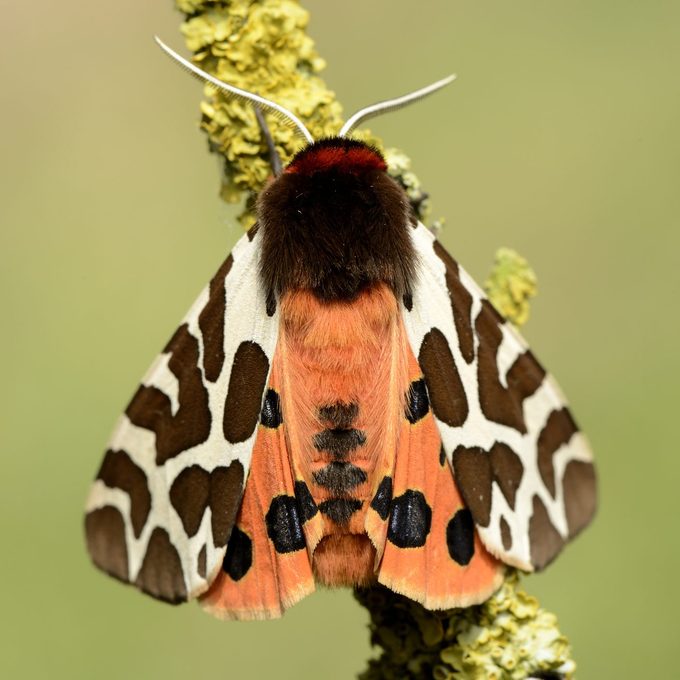Autumn ambassadors with astounding abilities, woolly bear caterpillars have wormed their way into our tool sheds, folklore, festivities and hearts.

What Is a Woolly Bear Caterpillar?

When you see fuzzy black-and-rust caterpillars moseying about your yard or workshop, they may be looking for a place to hibernate. Luckily, no matter how cold winter gets, these woolly bear caterpillars freeze but don’t die because they make glycerol, a kind of natural antifreeze. One species, the Arctic woolly worm, can even survive down to -90 F.
While most caterpillars become moths in just a few weeks, the Arctic woolly spends 14 years to complete the process. Still other species can medicate themselves against parasites.
Woolly bear caterpillars are cute and harmless, which makes them an ambassador of insects. They’re so popular that humans throw parties in their honor. The Woolly Bear Festival in Vermillion, Ohio, is purported to be the largest one-day festival in the state. North Carolina, Kentucky, Pennsylvania, New York and Ontario have celebrations as well.
On This Page
What Is a Woolly Bear Caterpillar?
Woolly bears — AKA fuzzy bears, woolly worms or banded woollys, depending on where you hail from — live in much of North America.
“There are many species,” says Jaret Daniels, a lepidopterist (someone who studies butterflies and moths) with the University of Florida. “But the banded woolly bear is probably the most well-known and recognizable.” That’s the black one with the rusty center stripe.
Sometimes they’re also called hedgehog caterpillars because, when disturbed, they curl up in a ball with their bristly hairs pointing outward. Those hairs, or setae, protect them from birds and other predators. It may come as a surprise, but the hairs don’t keep woolly bears warm. It actually helps them freeze!
What do Woolly Bear Caterpillars Eat?
Woolly bear caterpillars are not picky eaters, so they can be found most places where plants grow. They eat various herbs, weeds and native plants including asters, dandelions, clovers, lambs quarters, nettles and violets. They might also graze the garden for greens like cabbage and spinach, or climb a tree for maple, elm and birch leaves.
Do Woolly Bear Caterpillars Bite?
No, they are harmless except in rare cases when someone has an acute allergy to their hair. Some caterpillars have venom-filled hairs, which can be painful to humans, but woolly bears are as cute in your hand as they are on the ground. When you pick one up, it will probably play dead by curling up into a tight fuzzy ball.
Can Woolly Bear Caterpillars Predict Winter Weather?
That’s also a no. According to folklore, the rusty band on a woolly’s back predicts the severity of the winter. A narrow band means more severe weather, while a wider band foretells a mild season. Another version of the tale says the woollier the caterpillar’s coat, the colder the winter will be.
These myths date to colonial America, but entered popular culture in 1948 when a museum curator measured 15 woollys and suggested their predictions were true. But his study wasn’t terribly scientific. The broader scientific consensus suggests woolly winter predictions are on par with Punxsutawney Phil’s.
“The caterpillar’s coloring is not a predictor of future conditions,” Daniels says, “but simply the result of a combination of things, including age.”
Woolly bear caterpillars molt several times as they grow, which affects the width of their band. If there’s a good growing season, the caterpillar will be bigger and its rusty band will be narrower. So while this indicates how good the summer was, it doesn’t predict the winter. Also, band size and colorings vary between species.
What Do Woolly Bear Caterpillars Turn Into?

Tiger moths. Once the spring thaw begins and the plants return, woollys wake up. They eat for a few days, then craft a cocoon. In a matter of weeks they pupate (transform) and an isabella tiger moth, Pyrrharctia isabella, emerges. It’s a yellowish nocturnal moth with small black markings on top of its abdomen, a fuzzy head and a two-inch wingspan.
The moth then mates, lays eggs and dies in a few days. Two weeks later the new eggs hatch, and another generation of woolly bears set off on their journeys. This cycle happens twice a year, in the fall and spring. We notice woolly caterpillars in the fall because they’re out looking for a place to hibernate.
Are Woolly Bear Caterpillars in Trouble?
No. Daniels says he is not aware of any research indicating woolly caterpillars are in steep decline. However, he cautions that environmental changes, pesticides and habitat loss affect woollys just as they do other insects.
What Can I do to Help Woolly Bear Caterpillars?
If you come across a woolly bear on a sidewalk or in a parking lot, gently move it to a less dangerous spot. After that, Daniels says the best way to help woolly bears is to leave them alone. “Keep them wild,” he says. “Observe them in the wild and then let them do their thing.”
Other ways to help moth populations in general include reducing light pollution around your home and neighborhood, avoiding pesticides and planting native plants.




















